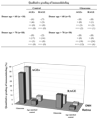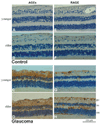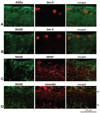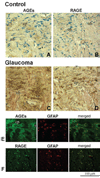Accelerated aging in glaucoma: immunohistochemical assessment of advanced glycation end products in the human retina and optic nerve head
- PMID: 17325164
- PMCID: PMC2492883
- DOI: 10.1167/iovs.06-0737
Accelerated aging in glaucoma: immunohistochemical assessment of advanced glycation end products in the human retina and optic nerve head
Abstract
Purpose: This study aimed to determine the association between advanced glycation end products (AGEs) and glaucoma based on the known synergism between oxidative stress with AGEs and the evidence of oxidative stress during glaucomatous neurodegeneration.
Methods: The extent and cellular localization of immunolabeling for AGEs and their receptor, RAGE, were determined in histologic sections of the retina and optic nerve head obtained from 38 donor eyes with glaucoma and 30 eyes from age-matched donors without glaucoma.
Results: The extent of AGE and RAGE immunolabeling was greater in older than in younger donor eyes. However, compared with age-matched controls, an enhanced accumulation of AGEs and an up-regulation of RAGE were detectable in the glaucomatous retina and optic nerve head. Although some retinal ganglion cells (RGCs) and glia exhibited intracellular immunolabeling for AGEs, increased AGE immunolabeling in glaucomatous eyes was predominantly extracellular and included laminar cribriform plates in the optic nerve head. Some RAGE immunolabeling was detectable on RGCs; however, increased RAGE immunolabeling in glaucomatous eyes was predominant on glial cells, primarily Müller cells.
Conclusions: Given that the generation of AGEs is an age-dependent event, increased AGE accumulation in glaucomatous tissues supports that an accelerated aging process accompanies neurodegeneration in glaucomatous eyes. One of the potential consequences of AGE accumulation in glaucomatous eyes appears to be its contribution to increased rigidity of the lamina cribrosa. The presence of RAGE on RGCs and glia also makes them susceptible to AGE-mediated events through receptor-mediated signaling, which may promote cell death or dysfunction during glaucomatous neurodegeneration.
Figures





Similar articles
-
Immunostaining of heat shock proteins in the retina and optic nerve head of normal and glaucomatous eyes.Arch Ophthalmol. 2000 Apr;118(4):511-8. doi: 10.1001/archopht.118.4.511. Arch Ophthalmol. 2000. PMID: 10766137
-
Hypoxia-inducible factor 1alpha in the glaucomatous retina and optic nerve head.Arch Ophthalmol. 2004 Sep;122(9):1348-56. doi: 10.1001/archopht.122.9.1348. Arch Ophthalmol. 2004. PMID: 15364715
-
Microglia in the optic nerve head and the region of parapapillary chorioretinal atrophy in glaucoma.Arch Ophthalmol. 1999 Aug;117(8):1050-6. doi: 10.1001/archopht.117.8.1050. Arch Ophthalmol. 1999. PMID: 10448748
-
The pathogenic role of transforming growth factor-β2 in glaucomatous damage to the optic nerve head.Exp Eye Res. 2011 Aug;93(2):165-9. doi: 10.1016/j.exer.2010.07.014. Epub 2010 Aug 12. Exp Eye Res. 2011. PMID: 20708611 Review.
-
Mitochondrial dysfunction and glaucoma.J Glaucoma. 2009 Feb;18(2):93-100. doi: 10.1097/IJG.0b013e318181284f. J Glaucoma. 2009. PMID: 19225343 Review.
Cited by
-
Transgenic inhibition of astroglial NF-κB restrains the neuroinflammatory and neurodegenerative outcomes of experimental mouse glaucoma.J Neuroinflammation. 2020 Aug 28;17(1):252. doi: 10.1186/s12974-020-01930-1. J Neuroinflammation. 2020. PMID: 32859212 Free PMC article.
-
Proteomic analysis of rat retina in a steroid-induced ocular hypertension model: potential vulnerability to oxidative stress.Jpn J Ophthalmol. 2008 Mar-Apr;52(2):84-90. doi: 10.1007/s10384-007-0507-5. Epub 2008 Apr 30. Jpn J Ophthalmol. 2008. PMID: 18626730
-
Relationship between Oxidative Stress Biomarkers and Visual Field Progression in Patients with Primary Angle Closure Glaucoma.Oxid Med Cell Longev. 2020 Aug 5;2020:2701539. doi: 10.1155/2020/2701539. eCollection 2020. Oxid Med Cell Longev. 2020. PMID: 32831992 Free PMC article.
-
Neuroinflammation in Primary Open-Angle Glaucoma.J Clin Med. 2020 Sep 30;9(10):3172. doi: 10.3390/jcm9103172. J Clin Med. 2020. PMID: 33007927 Free PMC article. Review.
-
Immunoproteomic analysis of potential serum biomarker candidates in human glaucoma.Invest Ophthalmol Vis Sci. 2012 Dec 13;53(13):8222-31. doi: 10.1167/iovs.12-10076. Invest Ophthalmol Vis Sci. 2012. PMID: 23150628 Free PMC article.
References
-
- Ahmed N. Advanced glycation end products—role in pathology of diabetic complications. Diabetes Res Clin Pract. 2005;67:3–21. - PubMed
-
- Thornalley PJ. Cell activation by glycated proteins: AGE receptors, receptor recognition factors and functional classification of AGEs. Cell Mol Biol (Noisy-le-grand) 1998;44:1013–1023. - PubMed
-
- Schmidt AM, Yan SD, Yan SF, Stern DM. The biology of the receptor for advanced glycation end products and its ligands. Biochim Biophys Acta. 2000;1498:99–111. - PubMed
-
- Yan SD, Chen X, Fu J, et al. RAGE and amyloid-beta peptide neurotoxicity in Alzheimer’s disease. Nature. 1996;382:685–691. - PubMed
-
- Ma L, Nicholson LF. Expression of the receptor for advanced glycation end products in Huntington’s disease caudate nucleus. Brain Res. 2004;1018:10–17. - PubMed
Publication types
MeSH terms
Substances
Grants and funding
LinkOut - more resources
Full Text Sources
Other Literature Sources
Medical

